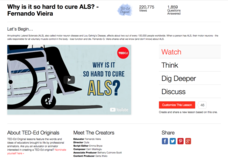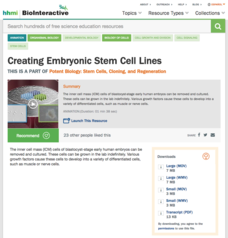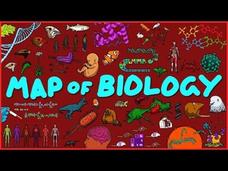Deep Look
There's Something Very Fishy About These Trees ...
Around 80 percent of the nitrogen in plants living in coastal forests comes from decaying fish. Viewers learn how salmon encourage the growth of forests with a scientific video that highlights interdependence, ecosystems, and the...
Howard Hughes Medical Institute
Structure of Dengue Virus
The dengue virus looks like a ball with multiple layers. View an animation of each layer while hearing a description of its properties, from the outer symmetrical units to the lipid envelope, the capsid, and finally the RNA genome.
Howard Hughes Medical Institute
The Chemical Structure of DNA
DNA follows specific rules when it comes to structure and pairings. Understand what DNA looks like, how it builds itself, and some of the rules that limit it. Individuals view animations showing details not observable under a microscope...
Howard Hughes Medical Institute
Running a Virochip Experiment
Thanks to a new understanding of DNA sequencing, doctors now study viruses outside human bodies. Observe an animation of the process using a Virochip to better understand viruses and how they connect to our DNA. By comparing results to...
Howard Hughes Medical Institute
The Lux Operon Controls Light Production
Bioluminescence, once considered rare, exists in around 90% of fish in the ocean. Understanding how genes communicate to produce light opens up a world of understanding for viewers. From being in the right setting to transcription to...
PBS
Seasonal Science: Hibernation
Without access to water, humans survive only a few days yet animals that hibernate seem to survive without water for months. Learn how animals survive hibernation in a video that is part of the Seasonal Science series. It addresses many...
TED-Ed
Why Is It so Hard to Cure ALS?
Although discovered over 150 years ago, scientists still struggle to find a cure or treatment for ALS. Viewers of a short video learn about the challenges facing scientists in their attempts to help those who suffer from ALS.
PBS
Seasonal Science: Raptor Migration
45 percent of all raptors migrate, but they don't follow the paths of other migrating birds. An extensive Seasonal Science series introduces the unique migration process of raptors. The narrator explains the extremely small migration...
PBS
Seasonal Science: Hurricane
Winter, spring, summer, fall, and hurricanes? With the help of a video that is part of a larger Seasonal Science series, learn why hurricanes have a season all their own. Viewers integrate knowledge of the causes of hurricanes, factors...
PBS
Seasonal Science: Pine Pollen
More than 125 species of pine trees exist, and each species can live over 100 years, with some living over 1,000 years—that's a lot of pine pollen! The Seasonal Science series explains why pine trees produce pollen. The video details the...
PBS
Seasonal Science: Frostbite
Fingers, toes, and nose. Oh, my! It's so cold outside. An animated video models the four-step progression of frostbite and how it affects the human body.
Howard Hughes Medical Institute
Prialt Blocks Motor Synapse in Fish
Have you ever wondered how to paralyze a fish? The cone snail produces venom that works, but what happens at a molecular level? A calcium channel blocker prevents muscle movement, enabling the slow-moving snail to catch faster, larger...
Howard Hughes Medical Institute
Prialt Blocks Pain Signaling in Mice
Prialt, a prescription pain medicine, is used to treat severe and chronic pain in humans, but is extremely toxic to fish. To understand how Prialt works, class members watch a short animated video that models how calcium channels that...
Howard Hughes Medical Institute
The Molecular Cascade in Bacterial Quorum Sensing
Antibiotics kill bacterial growth, but widespread use results in antibiotic resistance. Researchers wonder if quorum sensing might allow us to treat bacteria without the resistance. View an animation of quorum sensing as it regulates...
Howard Hughes Medical Institute
Signal Molecules Trigger Transcription Factors
How do transcription factors change the function of a cell? Learn how three similar cells find different functions based on their locations and the number of triggers available. Observe an animation of the process of assigning a trait...
Howard Hughes Medical Institute
Antigen Presentation and CTL
How does your body know when to present an immune response? Viewers observe how antigen presentation triggers the response and how this treatment helps attack viruses before they spread. The video also discusses the challenges of...
Howard Hughes Medical Institute
Creating Embryonic Stem Cell Lines
Even today's stem cells have a history—and it's more than 30 years old! Learn how stem cell lines grow in a lab. Observe the various experiments completed to determine how cells grow in human embryos.
Howard Hughes Medical Institute
Zebrafish Heart Regeneration
Zebrafish find popularity among aquarium owners for their beauty and biologists for their unique abilities. Biologists discovered zebrafish have the ability to regenerate damaged hearts. Use the video to observe and understand this...
Domain of Science
The Chain of Life
The narrator of a short animated video asks viewers to consider how they are just one link in a great chain of life that extends all the way back through time to the first single-cell organisms.
Domain of Science
The Map of Biology
Many define biology as the study of life but can't agree on a definition of life. Trying to explain all of the domains and subdomains of biology seems a bit easier than defining life. See a full map of the topics covered by the general...
Howard Hughes Medical Institute
Repellant Ephrin Signals Guide Limb Innervations
The foot bone connects to the leg bone, but how? Learn about how neurons grow in the proper direction thanks to signalling. Observe what happens when they encounter a repulsive ephrin signal and the correction process that takes place.
Howard Hughes Medical Institute
HIV Life Cycle
Almost half of the global population infected with HIV cannot afford treatment. To better understand this devastating disease, young scientists observe the life cycle of HIV. Through animation, they see the cell infection,...
Howard Hughes Medical Institute
Protease Inhibitors
Protease inhibitors currently treat HIV and hepatitis C, but in the future, might also be used to treat some cancers. Viewers learn how HIV spreads in the body and then observe what happens after the introduction of a protease...
Howard Hughes Medical Institute
U.S. AIDS Epidemic
The first AIDS cases in the United States were reported in June of 1981. AIDS quickly became an epidemic soon and the lack of a treatment or cure caused fear in the entire population. Viewers observe a geographical representation of the...























